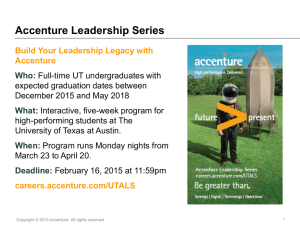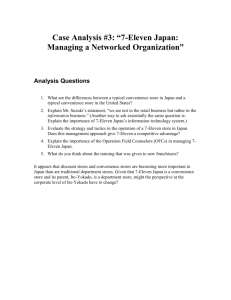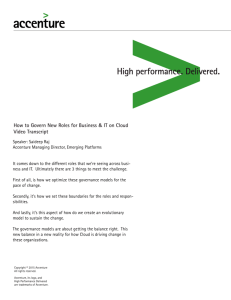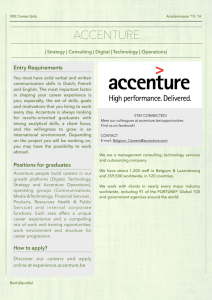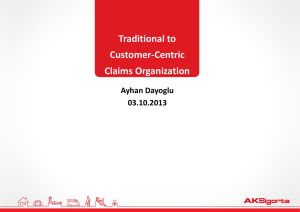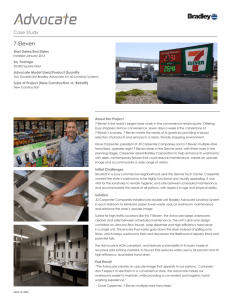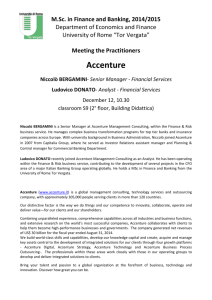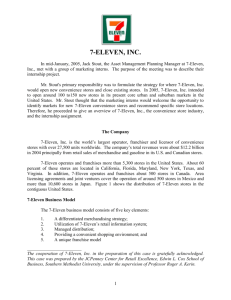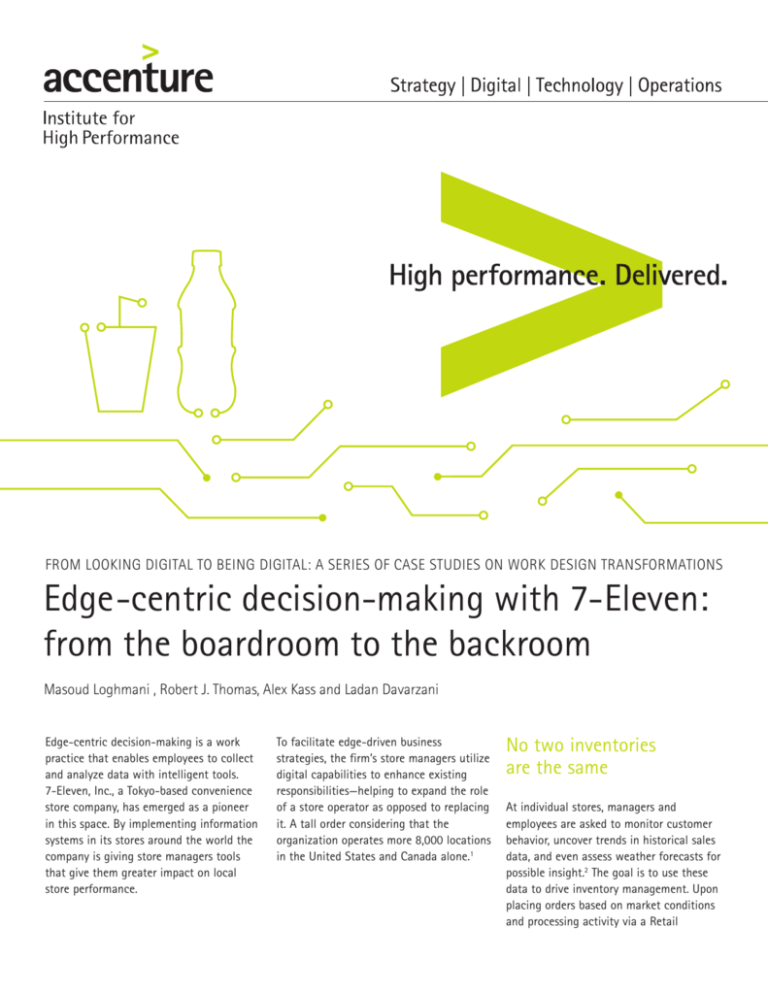
FROM LOOKING DIGITAL TO BEING DIGITAL: A SERIES OF CASE STUDIES ON WORK DESIGN TRANSFORMATIONS
Edge-centric decision-making with 7-Eleven:
from the boardroom to the backroom
Masoud Loghmani , Robert J. Thomas, Alex Kass and Ladan Davarzani
Edge-centric decision-making is a work
practice that enables employees to collect
and analyze data with intelligent tools.
7-Eleven, Inc., a Tokyo-based convenience
store company, has emerged as a pioneer
in this space. By implementing information
systems in its stores around the world the
company is giving store managers tools
that give them greater impact on local
store performance.
To facilitate edge-driven business
strategies, the firm’s store managers utilize
digital capabilities to enhance existing
responsibilities—helping to expand the role
of a store operator as opposed to replacing
it. A tall order considering that the
organization operates more 8,000 locations
in the United States and Canada alone.1
No two inventories
are the same
At individual stores, managers and
employees are asked to monitor customer
behavior, uncover trends in historical sales
data, and even assess weather forecasts for
possible insight.2 The goal is to use these
data to drive inventory management. Upon
placing orders based on market conditions
and processing activity via a Retail
Edge-centric decision-making with 7-Eleven: from the boardroom to the backroom
Information System (RIS), managers receive
regular feedback concerning the outcome
of his or her respective decision-making.3
The process helps to reinforce store
managers’ decision-making abilities
and, at times, can lead to one-on-one
counseling for a greater understanding
of inventory strategies.
Described as “a point-of-sale, touch-screen
system,”4 the technology has improved
collaboration between leadership and store
managers, allowed employees to analyze
customer activity instead of facilitating
backroom tasks, and provided greater
insight on the popularity of products.
Moving forward, 7-Eleven’s latest
incarnation of the original retail
information technology drills down into
the most specified of real-time retail
knowledge—enabling managers and
employees to determine when exactly
the store ran out of a specific product
(Example: a product sells out at 1:02 PM
or 4:05 PM each day or, more specifically,
every Monday) and then, as a result, build
a history of sales and determine if he
or she should be ordering more of that
particular product.
“Forecasting, not ordering”
Decisions must be pushed to the fringes
of the organization (actual stores) in
order to craft specific inventories that
reflect the values and interests of local
populations. Consequently, employees
and managers, with the help of field
consultants, must exercise judgment—
forecast what customers will want based
on current conditions. Steve Holland,
the Chief Technology and Chief Digital
Officer of 7-Eleven, has reinforced such
doctrines, emphasizing that employees
are “forecasting, not ordering”5 under
this system.
Skills now revolve around constant analysis
of in-store activity as opposed to spending
considerable amounts of time on backroom
responsibilities.6 For instance, if a specific
customer enjoys doughnuts, but will be
on vacation for a week, an employee is
expected to account for the occurrence
and relay data to a manager/system
for processing.7 How does this process
translate into a skillset? If something is
determined to be very popular and sells
out, the thought should not be to replenish
with the previous quantity, but to instead
double the request in order to satisfy
unmet demand.
The organization’s edge-centric strategies
are also influencing the company’s core.
Specifically, 7-Eleven is now the only
organization within its respective industry
to share granular/“shopping cart-level”
data with suppliers—a decision that is
enabling distributors to operate with
the greatest level of specificity when
determining what to stock and supply
to local 7-Eleven stores.8
2 | Accenture | Copyright © 2014 Accenture. All rights reserved.
What customers want
before they want it
Often times, success exists in small
windows of opportunity. In order to capture
potential revenue, 7-Eleven relies on
individual stores to analyze the preferences
of customers and act on them—benefiting
from a specific trend before it disappears.
This process is facilitated by managers and
employees that understand the clientele on
a first person basis as well as technology
that relays information that can only
be gathered by workers placed in local
convenience stores.
Ultimately, those closest to shifting
consumer preferences are leading a grassroots movement—bringing about a greater
connection between customers and the
company itself. In doing so, employees
and managers are becoming increasingly
malleable—changing their objectives to
match clients’ fluctuating interests.
Edge-centric decision-making with 7-Eleven: from the boardroom to the backroom
Notes
1. 7-Eleven, Inc. corporate website.
“About Us.” Accessed: June 21, 2013.
http://corp.7-eleven.com/AboutUs/
tabid/73/Default.aspx
2. “7-Eleven, Inc. Case-SMU.” Accessed:
June 21, 2013. rsethuraman.cox.smu.
edu/mktg6229/7Eleven%20Case-SMU.
doc
3. The Wall Street Journal. Ross, Jeanne
W. and Peter Weill. “Four Questions
Every CEO Should Ask About IT.”
Accessed: June 21, 2013. http://online.
wsj.com/news/articles/SB10001424052
748704336504576258561056702944
7. Baseline Magazine. Nash, Kim S.
“What’s In Store for 7-Eleven.”
November 1, 2002. http://www.
baselinemag.com/c/a/Projects-DataAnalysis/Whats-In-Store-for-7Eleven
8. Hayes, Frank. “7-Eleven’s SupplyChain Effort Will Have Benefits Way
Beyond 7-Eleven.” Accessed: April 18,
2013. http://www.fierceretail.com/
story/7-elevens-supply-chain-effortwill-have-benefits-way-beyond-7eleven/2013-04-18.
4. “7-Eleven, Inc. Case-SMU.” Accessed:
June 21, 2013. rsethuraman.cox.smu.
edu/mktg6229/7Eleven%20Case-SMU.
doc
5. Holland, Steven. Chief Technology
and Chief Digital Officer of 7-Eleven.
Interview by Masoud Loghmani. Phone
interview. Conducted between San
Jose, Dallas, and Boston. August 30,
2013 and September 9, 2013.
6. “Your New Day is Dawning at the Sign
of Opportunity – 7-Eleven Franchise
Opportunities.” Accessed: June 21,
2013. http://7-elevenfoac.com/data/7Eleven_Franchise_Overview.pdf.
3 | Accenture | Copyright © 2014 Accenture. All rights reserved.
About Accenture
Accenture is a global management
consulting, technology services and
outsourcing company, with approximately
289,000 people serving clients in more
than 120 countries. Combining unparalleled
experience, comprehensive capabilities
across all industries and business functions,
and extensive research on the world’s
most successful companies, Accenture
collaborates with clients to help them
become high-performance businesses and
governments. The company generated net
revenues of US$28.6 billion for the fiscal
year ended Aug. 31, 2013. Its home page is
www.accenture.com.
Copyright © 2014 Accenture
All rights reserved.
Accenture, its logo, and
High Performance Delivered
are trademarks of Accenture.
About the Accenture Institute
for High Performance
The Accenture Institute for High
Performance develops and publishes
practical insights into critical management
issues and global economic trends. Its
worldwide team of researchers connects
with Accenture’s consulting, technology
and outsourcing leaders to demonstrate
how organizations become and remain
high performers through original, rigorous
research and analysis.
About Accenture Technology Labs
Accenture Technology Labs, the dedicated
technology research and development
(R&D) organization within Accenture,
has been turning technology innovation
into business results for more than 20
years. Our R&D team explores new and
emerging technologies to create a vision
of how technology will shape the future
and invent the next wave of cutting-edge
business solutions.

